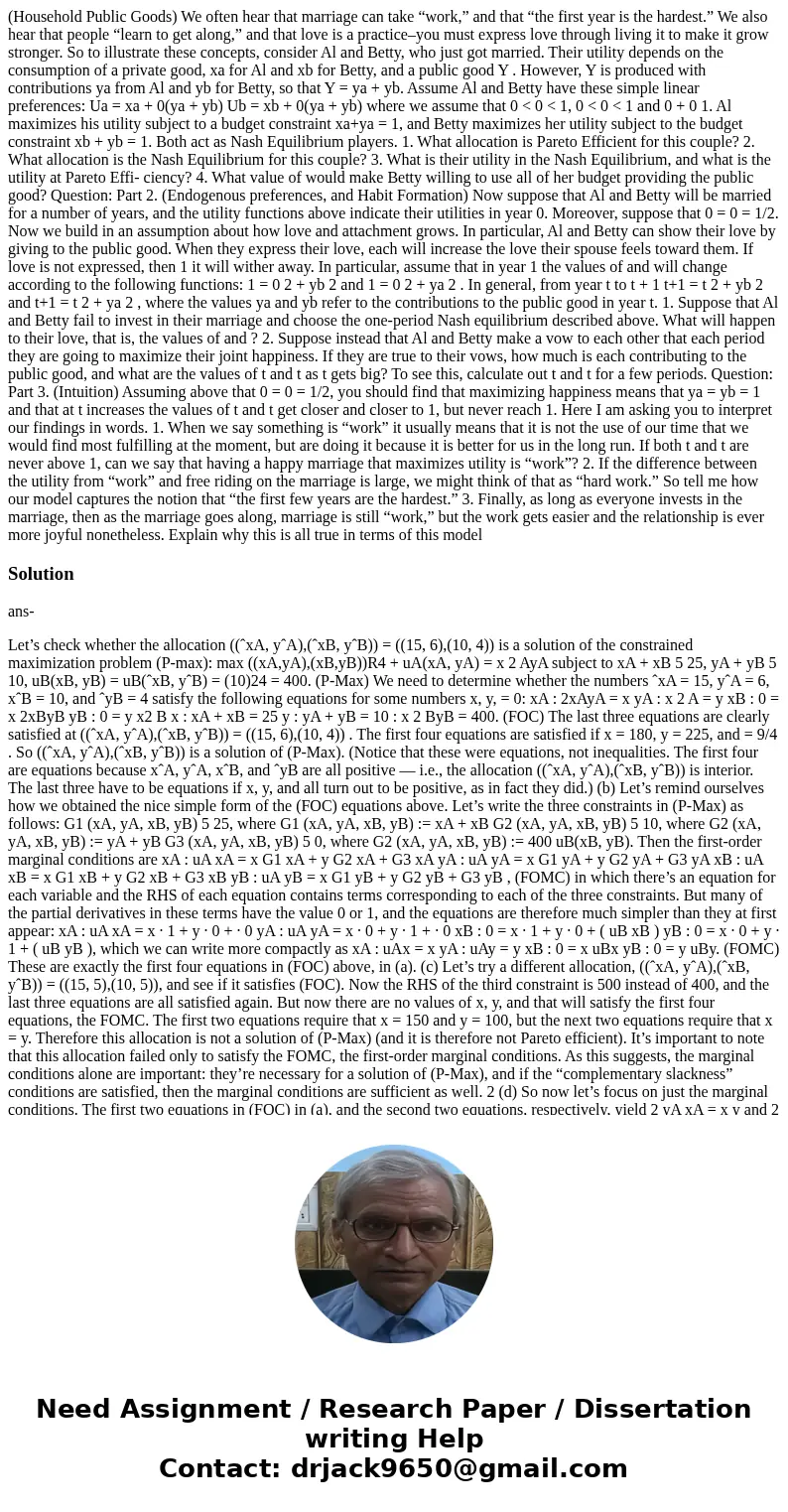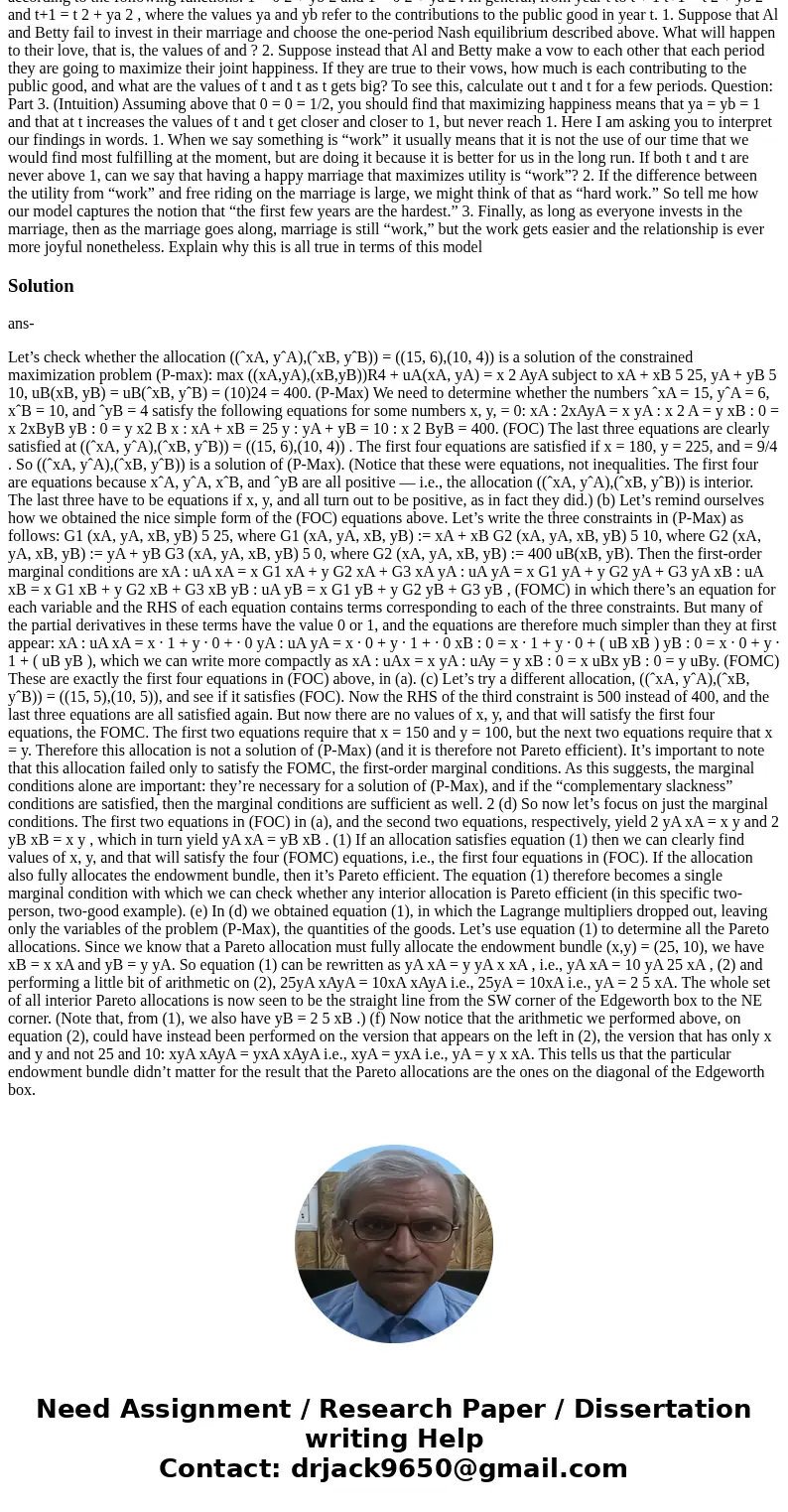Household Public Goods We often hear that marriage can take
(Household Public Goods) We often hear that marriage can take “work,” and that “the first year is the hardest.” We also hear that people “learn to get along,” and that love is a practice–you must express love through living it to make it grow stronger. So to illustrate these concepts, consider Al and Betty, who just got married. Their utility depends on the consumption of a private good, xa for Al and xb for Betty, and a public good Y . However, Y is produced with contributions ya from Al and yb for Betty, so that Y = ya + yb. Assume Al and Betty have these simple linear preferences: Ua = xa + 0(ya + yb) Ub = xb + 0(ya + yb) where we assume that 0 < 0 < 1, 0 < 0 < 1 and 0 + 0 1. Al maximizes his utility subject to a budget constraint xa+ya = 1, and Betty maximizes her utility subject to the budget constraint xb + yb = 1. Both act as Nash Equilibrium players. 1. What allocation is Pareto Efficient for this couple? 2. What allocation is the Nash Equilibrium for this couple? 3. What is their utility in the Nash Equilibrium, and what is the utility at Pareto Effi- ciency? 4. What value of would make Betty willing to use all of her budget providing the public good? Question: Part 2. (Endogenous preferences, and Habit Formation) Now suppose that Al and Betty will be married for a number of years, and the utility functions above indicate their utilities in year 0. Moreover, suppose that 0 = 0 = 1/2. Now we build in an assumption about how love and attachment grows. In particular, Al and Betty can show their love by giving to the public good. When they express their love, each will increase the love their spouse feels toward them. If love is not expressed, then 1 it will wither away. In particular, assume that in year 1 the values of and will change according to the following functions: 1 = 0 2 + yb 2 and 1 = 0 2 + ya 2 . In general, from year t to t + 1 t+1 = t 2 + yb 2 and t+1 = t 2 + ya 2 , where the values ya and yb refer to the contributions to the public good in year t. 1. Suppose that Al and Betty fail to invest in their marriage and choose the one-period Nash equilibrium described above. What will happen to their love, that is, the values of and ? 2. Suppose instead that Al and Betty make a vow to each other that each period they are going to maximize their joint happiness. If they are true to their vows, how much is each contributing to the public good, and what are the values of t and t as t gets big? To see this, calculate out t and t for a few periods. Question: Part 3. (Intuition) Assuming above that 0 = 0 = 1/2, you should find that maximizing happiness means that ya = yb = 1 and that at t increases the values of t and t get closer and closer to 1, but never reach 1. Here I am asking you to interpret our findings in words. 1. When we say something is “work” it usually means that it is not the use of our time that we would find most fulfilling at the moment, but are doing it because it is better for us in the long run. If both t and t are never above 1, can we say that having a happy marriage that maximizes utility is “work”? 2. If the difference between the utility from “work” and free riding on the marriage is large, we might think of that as “hard work.” So tell me how our model captures the notion that “the first few years are the hardest.” 3. Finally, as long as everyone invests in the marriage, then as the marriage goes along, marriage is still “work,” but the work gets easier and the relationship is ever more joyful nonetheless. Explain why this is all true in terms of this model
Solution
ans-
Let’s check whether the allocation ((ˆxA, yˆA),(ˆxB, yˆB)) = ((15, 6),(10, 4)) is a solution of the constrained maximization problem (P-max): max ((xA,yA),(xB,yB))R4 + uA(xA, yA) = x 2 AyA subject to xA + xB 5 25, yA + yB 5 10, uB(xB, yB) = uB(ˆxB, yˆB) = (10)24 = 400. (P-Max) We need to determine whether the numbers ˆxA = 15, yˆA = 6, xˆB = 10, and ˆyB = 4 satisfy the following equations for some numbers x, y, = 0: xA : 2xAyA = x yA : x 2 A = y xB : 0 = x 2xByB yB : 0 = y x2 B x : xA + xB = 25 y : yA + yB = 10 : x 2 ByB = 400. (FOC) The last three equations are clearly satisfied at ((ˆxA, yˆA),(ˆxB, yˆB)) = ((15, 6),(10, 4)) . The first four equations are satisfied if x = 180, y = 225, and = 9/4 . So ((ˆxA, yˆA),(ˆxB, yˆB)) is a solution of (P-Max). (Notice that these were equations, not inequalities. The first four are equations because xˆA, yˆA, xˆB, and ˆyB are all positive — i.e., the allocation ((ˆxA, yˆA),(ˆxB, yˆB)) is interior. The last three have to be equations if x, y, and all turn out to be positive, as in fact they did.) (b) Let’s remind ourselves how we obtained the nice simple form of the (FOC) equations above. Let’s write the three constraints in (P-Max) as follows: G1 (xA, yA, xB, yB) 5 25, where G1 (xA, yA, xB, yB) := xA + xB G2 (xA, yA, xB, yB) 5 10, where G2 (xA, yA, xB, yB) := yA + yB G3 (xA, yA, xB, yB) 5 0, where G2 (xA, yA, xB, yB) := 400 uB(xB, yB). Then the first-order marginal conditions are xA : uA xA = x G1 xA + y G2 xA + G3 xA yA : uA yA = x G1 yA + y G2 yA + G3 yA xB : uA xB = x G1 xB + y G2 xB + G3 xB yB : uA yB = x G1 yB + y G2 yB + G3 yB , (FOMC) in which there’s an equation for each variable and the RHS of each equation contains terms corresponding to each of the three constraints. But many of the partial derivatives in these terms have the value 0 or 1, and the equations are therefore much simpler than they at first appear: xA : uA xA = x · 1 + y · 0 + · 0 yA : uA yA = x · 0 + y · 1 + · 0 xB : 0 = x · 1 + y · 0 + ( uB xB ) yB : 0 = x · 0 + y · 1 + ( uB yB ), which we can write more compactly as xA : uAx = x yA : uAy = y xB : 0 = x uBx yB : 0 = y uBy. (FOMC) These are exactly the first four equations in (FOC) above, in (a). (c) Let’s try a different allocation, ((ˆxA, yˆA),(ˆxB, yˆB)) = ((15, 5),(10, 5)), and see if it satisfies (FOC). Now the RHS of the third constraint is 500 instead of 400, and the last three equations are all satisfied again. But now there are no values of x, y, and that will satisfy the first four equations, the FOMC. The first two equations require that x = 150 and y = 100, but the next two equations require that x = y. Therefore this allocation is not a solution of (P-Max) (and it is therefore not Pareto efficient). It’s important to note that this allocation failed only to satisfy the FOMC, the first-order marginal conditions. As this suggests, the marginal conditions alone are important: they’re necessary for a solution of (P-Max), and if the “complementary slackness” conditions are satisfied, then the marginal conditions are sufficient as well. 2 (d) So now let’s focus on just the marginal conditions. The first two equations in (FOC) in (a), and the second two equations, respectively, yield 2 yA xA = x y and 2 yB xB = x y , which in turn yield yA xA = yB xB . (1) If an allocation satisfies equation (1) then we can clearly find values of x, y, and that will satisfy the four (FOMC) equations, i.e., the first four equations in (FOC). If the allocation also fully allocates the endowment bundle, then it’s Pareto efficient. The equation (1) therefore becomes a single marginal condition with which we can check whether any interior allocation is Pareto efficient (in this specific two-person, two-good example). (e) In (d) we obtained equation (1), in which the Lagrange multipliers dropped out, leaving only the variables of the problem (P-Max), the quantities of the goods. Let’s use equation (1) to determine all the Pareto allocations. Since we know that a Pareto allocation must fully allocate the endowment bundle (x,y) = (25, 10), we have xB = x xA and yB = y yA. So equation (1) can be rewritten as yA xA = y yA x xA , i.e., yA xA = 10 yA 25 xA , (2) and performing a little bit of arithmetic on (2), 25yA xAyA = 10xA xAyA i.e., 25yA = 10xA i.e., yA = 2 5 xA. The whole set of all interior Pareto allocations is now seen to be the straight line from the SW corner of the Edgeworth box to the NE corner. (Note that, from (1), we also have yB = 2 5 xB .) (f) Now notice that the arithmetic we performed above, on equation (2), could have instead been performed on the version that appears on the left in (2), the version that has only x and y and not 25 and 10: xyA xAyA = yxA xAyA i.e., xyA = yxA i.e., yA = y x xA. This tells us that the particular endowment bundle didn’t matter for the result that the Pareto allocations are the ones on the diagonal of the Edgeworth box.


 Homework Sourse
Homework Sourse